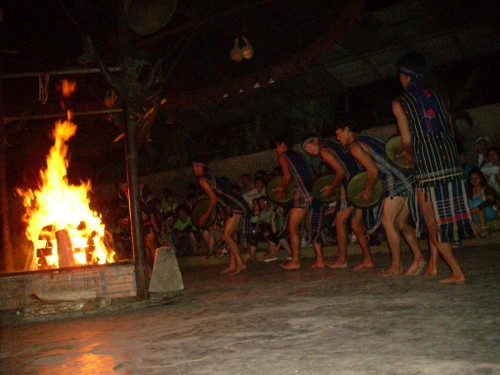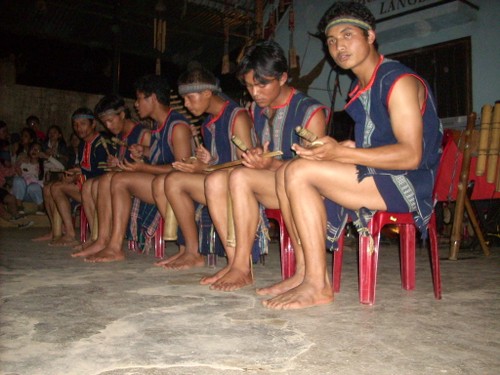Hello and welcome to the Sunday Show on the Voice of Vietnam. The feature comes to you every Sunday to introduce you to Vietnam’s land, people, culture and society.
Gong music is sacred to the Ede, for whom the sound of gongs evokes their origin myth, the Dam San epic. This story tells about the Ede leader, Dam San, longed to marry the Sun Goddess in order to subdue nature, rebel against heavenly authority and affirm the power of humanity. In today’s show, we would like to take you to the Central Highlands and spend a night there in the sound of the holy gongs. Here, you’ll find that no sound evokes the Central Highlands like the clear ring of a Gong.
 |
| Youngsters are dancing by the fire at the foot of Liang Bian Mountain. The sound of gongs drives away the tiredness and brings people closer to each other. Photo: Dao Thuy/VOV5 |
Called Cong or Chieng, these instruments accompany the celebrations and rituals of the minority peoples who live in the rugged Truong Son Mountains. Echoing through the valleys, the clatter of gongs brings to mind friendship, memories of past festivities and an invitation to join the hamlet in celebration.
A Ma Hrin, an elder of the Ede ethnic minority group, has been collecting gongs for decades. His collection includes pieces from the M’Nong, Ede and Jarai peoples, all carefully stored so that the younger generations will have the chance to learn about their musical heritage.
Ede people believe that before being born in human form, we all pass through seven lives as animals. Once borne as humans, we continue to evolve and gong music accompanies every significant step of a person’s life. The Ede identify these life stages as being born, performing the “work-giving” ceremony in which a person becomes a member of the community with full rights and responsibilities, choosing a spouse, building a house, praying for the good health of the elders, receiving friends from neighboring villages, praying for rain, and sending off a soul on the river to be reunited with his or her ancestors.
Like other Ede people, A Ma Hrin first heard the sound of a gong on the day he was born. That day, Ami or mother collected water in a bronze bowl, which Ama or father hit with a traditional stemmed wine jug. Ama performed this ritual to produce a gong-like noise, which informed the community and Yang or God that there was a new member of his family. Following this rite, Ama chose a name for his child, A Ma Hrin.
Long ago, the gongs were made of stone, wood and bamboo, which was later replaced with copper. Each minority group has its own version of this instrument, each of which is played in different style. A set of Ede gongs, for instance, includes 10 pieces, which can be stacked one inside the other. Sets of Ma and K’Ho gongs consist of 3 to 6 pieces, while a set of Ba Na gongs contains 6 to 9 instruments. The Rap Jarai, meanwhile, play sets of 21 gongs. Ede gongs are played by men, while it is women who play gongs in the Bih minority.
The gongs of the Ba Na have a powerful bass voice, like wind through the jungle, Jarai gongs are quick and light, inviting girls and boys to perform the traditional Xoan line-dance, in which they stand shoulder-to-shoulder. The Xe Dang’s gongs are fast and warlike, while those of Ma and M’Nong seem to sob. The gong music of the Ede people, meanwhile, tumbles out like a waterfall, as if voicing the longing of the tribe’s mythical founder Dam San. With its red soil that overflowed from the Tu M’Rong and Chu M’Gar volcanoes, its endless coffee and rubber plantations, and the meandering Serepok and Sesan Rivers that descend in hundreds of waterfalls, this land is bewitchingly beautiful. Gong music is one means by which the people who live here express the beauty that surrounds them, as in the Plier melody, which falls fast and hard as hail and celebrates the landscape of the Central Highlands. Music is also used to enlist the forces if nature to the village’s aid, for instance the E Wa A Ngin melody, which calls upon the rice spirit to enrich the community.
 |
| Men in the Central Highlands learn how to play gongs since their childhood. They love the sound of gongs and the enthusiasm of the dances. Photo: Dao Thuy/VOV5 |
The region’s most famous Chieng orchestra is that of Koh Sia village, which performed in the 1991 Asia Pacific Music Festival in HCM City and in the Czech Republic in October 1998. Although the rhythm produced by the young boys is not as sharp as that made by their elders, it is enough to encourage the village girls to jump into a Xoan dance.
The glittering designs on their dresses form magical patterns as they twirl, while the crystal sounds of the gongs travel across the silent valleys. Beeiing bong, beeiing bong… Through a light curtain of rain, the sound echoes, calling friends near and far to come and listen to the holy gongs, eat new rice, drink rice wine and celebrate.
As the word of a tradition Ede song suggest: “ Let’s drink, dear, get drunk, dear. In the highland night, the light of the moon will light our way home.”
Dao Thuy